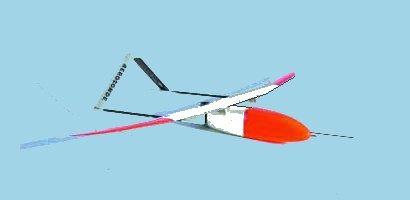Back to Intensity Change projects
|
Back to Main Projects Page
Hurricane Unmanned Aircraft Systems (UAS) Demonstration
Project 2006
Principal Investigator:
Joseph Cione
Key Collaborators:
Nick Carrasco (HRD/CIMAS)
Peter Bale (Aerosonde Corporation)
Greg Holland (NCAR/Mesoscale And Microscale Meteorology Division)
Peter Turlington (NASA/Wallops Flight Facility)
Chris Sisko (NOAA/Tropical Prediction Center)
Aerosonde Corp.
NASA's Wallops Flight Facility
Objective:
 The primary objective of this project is to demonstrate the Aerosonde
platform's overall capabilities (including survivability) in a hurricane
environment.
The primary objective of this project is to demonstrate the Aerosonde
platform's overall capabilities (including survivability) in a hurricane
environment.
Four key scientific objectives would be to :
- Fully explore Aerosonde's potential to effectively observe critical regions
of the tropical cyclone boundary layer environment.
- Conduct low level missions into the eyewall region of hurricanes at
altitudes of 300m or lower.
- Conduct several low level flights into several tropical cyclones including
multiple aircraft missions.
- Continue to transmit real-time surface wind, pressure, and thermodynamic
data to NOAA's OAR in direct support of operational
requirements.
- Undertake research aimed at improve understanding of the high-wind boundary
layer and the exchanges of heat, moisture, and momentum across the oceanic
surface.
- Provide calibration and verification data sets for NASA.
- As a direct result of improved understanding of the hurricane boundary
layer and air-sea environment, look for potential opportunities to contribute
towards future operational model development.
- Look at using these unique new data to establish new NOAA
operational goals and requirements.
Method:
Conduct a Hurricane Aerosonde Demonstration Project in Key West
The demonstration project is scheduled to run for thirty days, from
Sept. 1 to Sept. 30, 2006, in cooperation with Aerosonde Corp., NASA,
and the U.S. Navy. The Aerosondes will be deployed at Key West Naval Air
Station (NASKW), and will have an approximate 300 nautical mile operational
radius from the deployment base.
Single or multiple Aerosonde experiments will be coordinated with
NOAA and AFRES aircraft missions during the 2006 demo. The following
experiments are possible:
- Inflow Experiment - Sample the tropical cyclone inflow
layer's thermodynamic structure by flying within 500 feet of the
surface in the inner core, spiraling in on the winds of the storm.
The continuous observations of very low level winds may result in
establishing the location and magnitude of storm's maximum wind speed.
- Tropical Cyclone Thermodynamic Asymmetry Experiment - The
Aerosonde would fly a fixed radius orbit (~200 km from the center) either
prior to or after its spiral in toward the center in order to improve the
radial accuracy of the 34kt, 50kt, and 64kt wind estimates.
- Eye Sounding Experiment - The Aerosonde would make a corkscrew
sounding within the eye up to 10,000 feet, to find any early detection signal
of rapid intensity changes. This would require a clear, discernible eye
when there are no AFRES flights in progress and with close coordination
with any NOAA flights at the time of the sounding.
Background:
Simply stated, continuous observation of thermodynamic (temperature
and moisture) and kinematic (wind) structure of the near-surface
hurricane environment has never been documented in a hurricane. This
environment, where the atmosphere meets the sea, is critically
important since it is where the ocean's warm water energy is directly
transferred to the atmosphere just above it. The TC surface layer is
also important because it is where we find the strongest winds in a
hurricane and coincidentally, the level at which most of us live
(i.e. at/near the surface). As such, observing and ultimately better
understanding this region of the storm is crucial if we hope to
improve our ability to make accurate forecasts of TC intensity change.
Enhancing this predictive capability would not only save our economy
billions of dollars but more importantly it would save countless lives.
Funding for this project comes from NASA, NOAA/NMAO, NOAA Aircraft
Operations Center, and NOAA Hurricane Research Division.
Accomplishments:
Key references:
- Cione, J.J., and E. W. Uhlhorn 2003: Sea surface temperature
variability in hurricanes: Implications with respect to intensity
change. Mon. Wea. Rev., v.131, pp.1783-1796
- Wroe, D.R. and G.M. Barnes 2003: Inflow Layer Energetics of
Hurricane Bonnie (1998) near Landfall. Mon. Wea. Rev.
v.131 pp. 1600-1612
- Cione, J.J., P. J. Black and S. Houston 2000: Surface observations
in the hurricane environment. Mon. Wea. Rev, v.128 pp.1550-1561
- Dunion, J.P., and C.S. Velden, 2004: The impact of the Saharan Air
Layer on Atlantic tropical cyclone activity. Bull. Amer. Meteor.
Soc., v.85 no. 3, pp.353-365
Back to Intensity Change projects
|
Back to Main Projects Page
Last modified: 7/25/2006
|
|
 The primary objective of this project is to demonstrate the Aerosonde
platform's overall capabilities (including survivability) in a hurricane
environment.
The primary objective of this project is to demonstrate the Aerosonde
platform's overall capabilities (including survivability) in a hurricane
environment.
